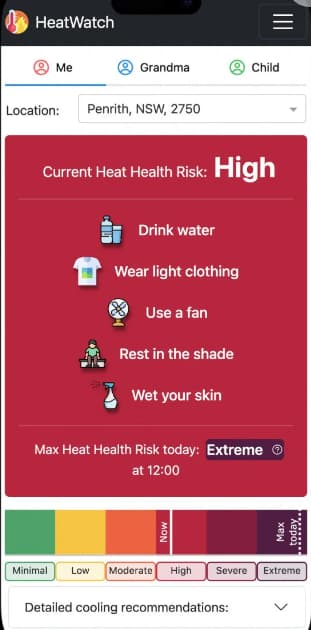The University of Sydney has launched a mobile app that collates a range of real-time weather data to calculate heat-related health risks across Australia.
The HeatWatch app provides users with current and seven-day heat risk forecasts – as well as a heat risk graph covering half-hour increments – for any postcode in Australia. It also offers practical, scientifically backed advice for staying cool according to the risk level.
Dr Federico Tartarini, Affil.AIRAH, developed the app alongside Professor Ollie Jay, director of the university’s Heat and Health Research Incubator. Tartarini, winner of AIRAH’s 2023 Future Leader award, told HVAC&R News that HeatWatch uses air temperature, relative humidity, wind speed, and solar radiation data to calculate risks.
“We get the hourly dry-bulb, relative humidity, wind speed, and solar radiation data for each location,” Tartarini says. “These data, together with personal parameters like clothing, activity level, and physiological variables are used as inputs for a human heat balance model to estimate the heat health risk. Forecast data are updated each time the user changes the location, opens the application, and/or on an hourly basis.”
A personal touch
The app’s personalisation feature allows users to add the following information to help fine tune their heat risk calculation:
- Age group
- Medical and personal risk categories
- Medications
- Work setting (indoor or outdoor, sedentary or active)
- Clothing.
“Age, co-morbidities, illnesses, clothing, solar radiation, and activity all affect the ability of our body to cope in the heat,” Tartarini says. “In addition, our application provides personalised cooling recommendations that people in the community can use to keep cool.
“All our recommendations are evidence-based and they are simple, low-cost, and easy to implement. Our main aim is to protect the most vulnerable people in the community, who may not have access to air conditioning.”

The app’s recommendations include practical measures people can take, such as drinking water (even when they are not thirsty), keeping their skin wet, placing crushed ice in a wet towel and wrapping it around their neck, and dipping their feet in cold water. Users can create up to three profiles, allowing them to take care of vulnerable loved ones as well as themselves.
Tartarini and his team consulted more than 150 people from a range of communities through focus groups while developing the app, a process he says was extremely useful.
Much-needed respite
One of HeatWatch’s first applications is within another University of Sydney program: the Homelessness and Heat Emergency Activation Team’s (HHEATeam) cooling hub initiative. This project provides a cool, welcoming, and safe space for people experiencing homelessness to cool down during extreme heat events.
The HHEATeam, led by Dr Timothy English, uses HeatWatch to predict dangerous heat events. It then implements the app’s recommendations to help up to 54 vulnerable people at a time.
“Tim has created different profiles (on HeatWatch) for people who may experience homelessness,” Tartarini says. “This allows him to calculate the forecast heat health risk for this vulnerable group of people. He then deploys the cooling hubs when the heat health risk exceeds a certain threshold.”
Tartarini says the team is taking a broader approach to raising awareness.
“While our application is free to use, some of the most vulnerable groups may not be able to access it using a smartphone,” he says. “We are also planning to display HeatWatch on public displays in community centres, libraries, and police stations. This will enable us to reach the most vulnerable groups.”
The project is funded by the NSW Reconstruction Authority (formally Resilience NSW) through its Disaster Risk Reduction Funding scheme.



Leave a Reply